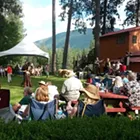Those streets I crossed are known today as Belltown, where killer condos and trendy clubs fill every available space. But when I walked them, there were homeless people sleeping in vacant doorways and longshoremen waiting outside the union hall to get picked up to go to whatever random job presented itself that morning. There were a few pioneers starting to emerge there -- Patagonia opened a shop, there were some spillover boutiques from the market and, of course, the longtime mainstay Mama's Mexican Kitchen -- but there were no cranes in the sky, no "For Sale" signs going up.
After I left those jobs for grad school, the next time I went into what people had started calling "Belltown" a few years later, I couldn't believe it. It was a completely different story, with hard hats everywhere and nary an empty doorway for sleeping.
Today, Belltown is a neighborhood where thousands of people live. In fact, for much of the past decade, downtown Seattle has been the hottest real estate market on the West Coast for housing, according to Charles Royer, who was mayor of Seattle when Belltown was developed.
Those walks have come back to me lately, as it's kind of feeling like that around here lately, with condo projects popping up all over downtown Spokane.
& lt;span class= & quot;dropcap & quot; & W & lt;/span & e've been writing about the importance of making downtown Spokane a neighborhood for years -- since well before anybody ever heard of Portland's Pearl District. But only recently has Spokane been ready, with enough pent-up demand to get several big projects off the ground.
Like Belltown, downtown Spokane kind of limped along for years, with just the right projects -- River Park Square, the Davenport Hotel -- coming together at the right times to keep it viable. Now that success is here, with more on the way in the form of Kendall Yards, the Great Gorge Park and, perhaps, a new farmers' market, you can't help but pinch yourself and wonder, "Am I still in Spokane?"
That's the feeling I had over the weekend when I got to visit Dan Spalding's cool loft in an old downtown building -- a place he says was "a flophouse" before he bought it. A labor of love for 12 years, Spalding finally has his quirky, exposed-brick units full of tenants, and he's anxious to do another project.
But as we stood on his roof and surveyed the expanse of our slowly awakening downtown, we both hoped things would move beyond the million-dollar-condo dynamic to allow for people of more humble, reality-based income levels to move in, too. As success comes to downtown Spokane, we need to be sure not to turn it into high-end playground where wealthy retirees scoop up the units and live there for seven months a year.
When I covered small suburban Boston towns as a reporter, I remember writing about developers bristling over state rules that forced them to include a percentage of affordable housing units with every development they built. In Seattle, new high-rise housing is coming with similar requirements. As the boom hits, Spokane needs to consider how to address the issue of affordability.
Downtown should be a melting pot of a neighborhood, with all kinds of different people calling it home. The hipster-by-night/office-worker-by-day is as important as the CEO wanting to lose his yard and walk to work.
& lt;span class= & quot;dropcap & quot; & D & lt;/span & on Barbieri, whose companies have built lots of affordable housing units over the years, says he sees it as a process -- the high-end stuff comes in first, with the more affordable units coming in next.
"A lot of the high-end, that's been the pent-up part of the market," he says, adding that it's hard to pass on building out the high-end stuff when demand is so strong. (His Upper Falls condos, near the Flour Mill, have already sold 29 of 32 units at between $500,000 and $1.3 million each.)
"But," he adds, "you can bring more affordable units into the mix."
Barbieri's bigger worry is over the challenges in transportation, linking all parts of downtown so residents really can ditch their cars. And he also worries about the riverbank, adding that under current laws, his project could have been twice its six stories; instead, his group chose to keep it more in scale with the surroundings. As this boom continues, any land on the river will be at a premium, and the city may have to become a more aggressive referee for what's appropriate. For example: Should special steps be taken to protect Peaceful Valley, which will clearly become a target of development? That's just one of many questions that are sure to emerge as Spokane wrestles with the price of success.
& lt;span class= & quot;dropcap & quot; & S & lt;/span & till, these are good problems to have. Reversing (or at least slowing) the migration to the suburbs is a welcome social trend that's been 60 years in the making. People are left cold by losing human interaction every night when they close that garage door; they want to be out, in restaurants, in pubs, interacting -- being social. And they're getting pretty sick of $3-a-gallon gas, too.
People in cities all along the West Coast are proving that reurbanization is a real social sea change, not a fad. And as is usually the case with Spokane, it may take an extra decade or so, but the trend is finally hitting here.















